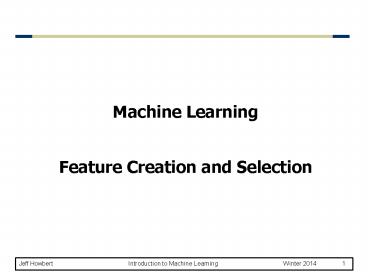Machine Learning Feature Creation and Selection - PowerPoint PPT Presentation
1 / 18
Title:
Machine Learning Feature Creation and Selection
Description:
Machine Learning Feature Creation and Selection – PowerPoint PPT presentation
Number of Views:115
Avg rating:3.0/5.0
Title: Machine Learning Feature Creation and Selection
1
Machine LearningFeature Creation and Selection
2
Feature creation
- Well-conceived new features can sometimes capture
the important information in a dataset much more
effectively than the original features. - Three general methodologies
- Feature extraction
- typically results in significant reduction in
dimensionality - domain-specific
- Map existing features to new space
- Feature construction
- combine existing features
3
Scale invariant feature transform (SIFT)
- Image content is transformed into local feature
coordinates that are invariant to translation,
rotation, scale, and other imaging parameters.
SIFT features
4
Extraction of power bands from EEG
- Select time window
- Fourier transform on each channel EEG to give
corresponding channel power spectrum - Segment power spectrum into bands
- Create channel-band feature by summing values in
band
time window
Multi-channel power spectrum (frequency domain)
Multi-channel EEG recording (time domain)
5
Map existing features to new space
- Fourier transform
- Eliminates noise present in time domain
Two sine waves
Two sine waves noise
Frequency
6
Attribute transformation
- Simple functions
- Examples of transform functions xk log( x
) ex x - Often used to make the data more like some
standard distribution, to better satisfy
assumptions of a particular algorithm. - Example discriminant analysis explicitly models
each class distribution as a multivariate Gaussian
log( x )
7
Feature subset selection
- Reduces dimensionality of data without creating
new features - Motivations
- Redundant features
- highly correlated features contain duplicate
information - example purchase price and sales tax paid
- Irrelevant features
- contain no information useful for discriminating
outcome - example student ID number does not predict
students GPA - Noisy features
- signal-to-noise ratio too low to be useful for
discriminating outcome - example high random measurement error on an
instrument
8
Feature subset selection
- Benefits
- Alleviate the curse of dimensionality
- Enhance generalization
- Speed up learning process
- Improve model interpretability
9
Curse of dimensionality
- As number of features increases
- Volume of feature space increases exponentially.
- Data becomes increasingly sparse in the space it
occupies. - Sparsity makes it difficult to achieve
statistical significance for many methods. - Definitions of density and distance (critical for
clustering and other methods) become less useful. - all distances start to converge to a common value
10
Curse of dimensionality
- Randomly generate 500 points
- Compute difference between max and min distance
between any pair of points
11
Approaches to feature subset selection
- Filter approaches
- Features selected before machine learning
algorithm is run - Wrapper approaches
- Use machine learning algorithm as black box to
find best subset of features - Embedded
- Feature selection occurs naturally as part of the
machine learning algorithm - example L1-regularized linear regression
12
Approaches to feature subset selection
- Both filter and wrapper approaches require
- A way to measure the predictive quality of the
subset - A strategy for searching the possible subsets
- exhaustive search usually infeasible search
space is the power set (2d subsets)
13
Filter approaches
- Most common search strategy
- Score each feature individually for its ability
to discriminate outcome. - Rank features by score.
- Select top k ranked features.
- Common scoring metrics for individual features
- t-test or ANOVA (continuous features)
- ?-square test (categorical features)
- Gini index
- etc.
14
Filter approaches
- Other strategies look at interaction among
features - Eliminate based on correlation between pairs of
features - Eliminate based on statistical significance of
individual coefficients from a linear model fit
to the data - example t-statistics of individual coefficients
from linear regression
15
Wrapper approaches
- Most common search strategies are greedy
- Random selection
- Forward selection
- Backward elimination
- Scoring uses some chosen machine learning
algorithm - Each feature subset is scored by training the
model using only that subset, then assessing
accuracy in the usual way (e.g. cross-validation)
16
Forward selection
- Assume d features available in dataset FUnsel
d - Optional target number of selected features k
- Set of selected features initially empty FSel
? - Best feature set score initially 0 ScoreBest 0
- Do
- Best next feature initially null FBest ?
- For each feature F ? FUnsel
- Form a trial set of features FTrial FSel F
- Run wrapper algorithm, using only features
Ftrial - If score( FTrial ) gt scoreBest
- FBest F scoreBest score( FTrial )
- If FBest ? ?
- FSel FSel FBest FUnsel FUnsel FBest
- Until FBest ? or FUnsel ? or FSel k
- Return FSel
17
Random selection
- Number of features available in dataset d
- Target number of selected features k
- Target number of random trials T
- Set of selected features initially empty FSel
? - Best feature set score initially 0 ScoreBest
0. - Number of trials conducted initially 0 t 0
- Do
- Choose trial subset of features FTrial randomly
from full set of d available features, such that
FTrial k - Run wrapper algorithm, using only features Ftrial
- If score( FTrial ) gt scoreBest
- FSel FTrial scoreBest score( FTrial )
- t t 1
- Until t T
- Return FSel
18
Other wrapper approaches
- If d and k not too large, can check all possible
subsets of size k. - This is essentially the same as random selection,
but done exhaustively.





















![Investigations on Automatic Behavior-based System Design [A Survey on] Hierarchical Reinforcement Learning PowerPoint PPT Presentation](https://s3.amazonaws.com/images.powershow.com/6219810.th0.jpg?_=20150306026)









